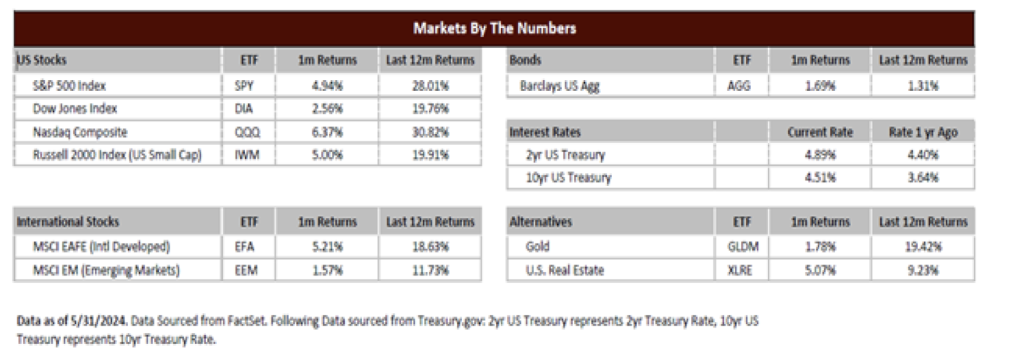Stocks rallied in May and ended the month near all-time highs for the S&P 500. The index
has been buoyed by technology, communications, and consumer companies that are large
and have a significant influence on overall performance.
On the economic front, recent data has largely been within the range of expectations on
inflation, jobs, and GDP. Actions of the US Federal Reserve (Fed), based on the trends of
economic data, continue to be front of mind for investors. The current data paints the
picture of a largely resilient economy but also one with lingering inflation that is stickier
than most predicted.
Because of this resilient economy, the Fed has not transitioned to rate cuts that were
expected early in the year. This has been a headwind for bonds and the main reason bond
performance has been negative year to date. Despite the year-to-date performance, we
believe bonds are still relatively opportunistic. Bonds have had higher than average
volatility but are still less risky than the stock market. With higher rates, current yields
provide greater income compared to just two or three years ago. We also believe rates
are closer to a high point rather than a low point, and our opinion is the Fed’s next move is
more likely to be an interest rate cut (even if later than expected). If this is correct, then
bonds could provide good current yield and may provide better second half price
performance if interest rates were to fall.
With regard to stocks, the level of concentration in the top ten stocks in the S&P 500 has
actually increased in 2024. These top ten stocks now account for over 30% of the size of
the index. While we do not believe this is any harbinger of doom, stocks like Microsoft
(MSFT), Amazon (AMZN), Apple (AAPL), Alphabet (GOOG), and Nvidia (NVDA) have a
large influence on overall market trends – both up and down. If these stocks were to
falter, it would take a much broader rally from the other stocks to offset the performance
decline of the top ten.
As always, our analysis of markets is based on business fundamentals. Those
fundamentals are the health of the economy, the health and growth of companies within
the economy, and the valuations of those businesses (or what we pay for those
companies). When viewed under this lens, conditions are still on relatively stable ground.
Economic trends are resilient and inflation is sticky but still headed in the right direction.
Earnings continue to be relatively strong and company outlooks and commentary do not
suggest imminent collapse. Valuation is the weakest factor as the S&P 500 is more
expensive now compared to long-term averages. Valuation, however, is not a great
indicator of near-term trends but does suggest more muted performance over the
medium term.
As a result, we remain relatively optimistic but understand that it is often the things we do
not see coming that have the biggest negative influence on performance. That is why we
advocate for a prudent approach to investing that includes assets to protect from decline
as well as growth assets that participate in long term positive trends. The balance and
weight of these assets should be based on a custom-tailored investment plan that
establishes goals while simultaneously managing for risk and time horizon.

by Jeremy Bryan, CFA
Posted here on June 4, 2024
